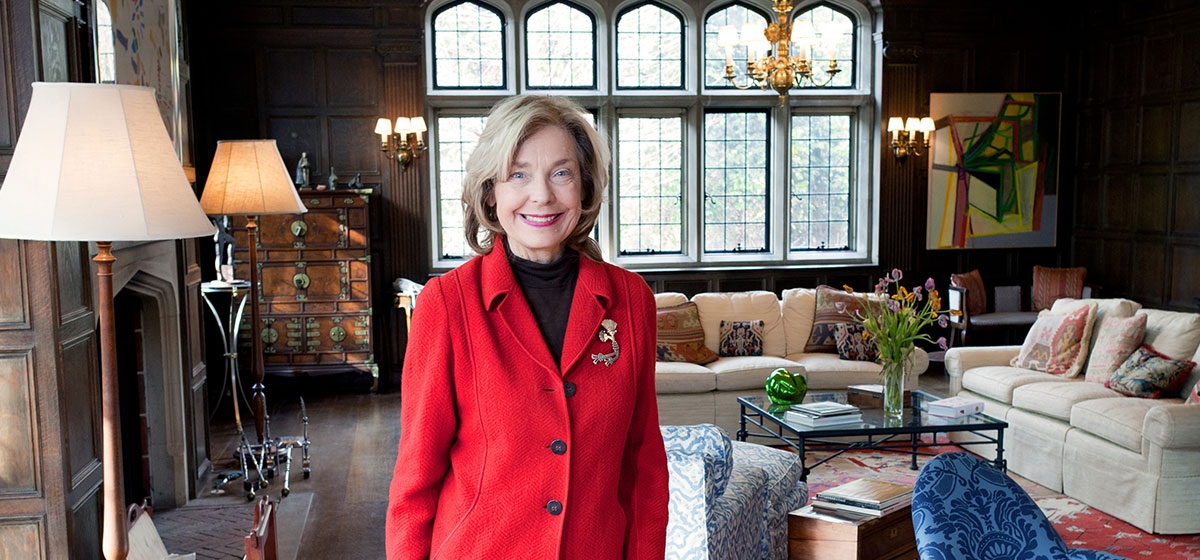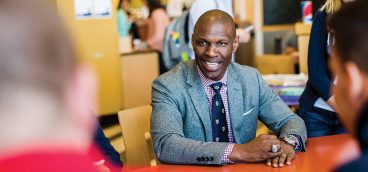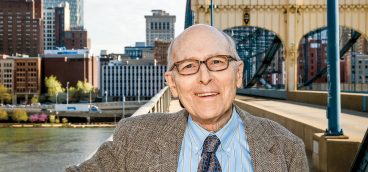Jacqueline C. Morby, Businesswoman & Private Equity Investor

Pittsburgh has changed dramatically since I first arrived here in 1988. It’s much more entrepreneurial now.
There are more small companies and greater interest in financing them. We still have a problem, however. We don’t have a Microsoft. None of the technology companies that originated locally have blossomed into anything particularly huge, which is something that Pittsburgh has sorely needed for a long, long time. After all, big companies produce pools of experienced managers and executives and, in time, spin off businesses that can further boost a local economy.
My area of specialty has been technology, and, locally, Carnegie Mellon University (CMU) has a very fine tech program. But for years its brightest and most ambitious graduates seemed to head for California or Boston to join companies there. Fortunately, for the past decade or so, good people like Lenore Blum at CMU’s Olympus and, of course, organizations such as Innovation Works and the Pittsburgh Life Sciences Greenhouse, have been providing start-up assistance to the city’s most enterprising technology graduates. And it’s great that Google and Intel are both in Pittsburgh now. Large and successful companies such as these are innovators and provide opportunities for young people to stay and work here and, perhaps, to produce spin-offs later on.
From a business perspective, Pittsburgh’s problem is partly management. We don’t have a large enough group of successful technology people who can take good companies further. Also, to be frank, we haven’t had good luck. How is it that Microsoft ended up in the state of Washington? It wasn’t an ideal place for a technology company, but it was good enough to have spawned Bill Gates. Microsoft should have been located in Silicon Valley. It’s totally understandable why Google, Facebook and all the others are situated around Palo Alto. That area maintains a large supply of technology workers and corporate managers, not to mention loads of venture capital.
But why has Palo Alto been more successful than a great established eastern city such as Boston? It seems that Boston, home of MIT, should have done just as well. In my opinion, geography is partly to blame. California is flat. Let’s say you work for Intel and decide to break off and start your own company. You put up a sign and everyone can see it from the freeway. Every day people drive by, see your sign and think, “I knew that person and I’m smarter than he or she is. I’m going to start my own company.” This open visual plane inspires people. They can see and not just hear about all the young companies springing up out there. In Boston, it isn’t that way. There are too many trees and hills disturbing the sightlines. We have the same thing in Pittsburgh. But I’m proud to say that I’ve made three major investments here over the years: Medrad, in the early 1980s; Ansys, Inc., in the mid-1990s, which is one of our most successful companies, worth about $5 billion today; and, around 2000, HVL/Douglas Labs. TA Associates did well with all three.
I was born in Sacramento and grew up in nearby Marysville, Calif., population 7,000, a small farming community. My father was president of the community college and I went to high school there and then to Stanford to study psychology. My husband, Jeff Morby, went to Stanford, too, and that’s where we met. I subsequently got a teacher’s credential at UCLA and became a substitute teacher—kindergarten through second grade—for several years, only to discover that I was not meant for teaching. It exhausted me. But that experience helped me. I had always been very shy and couldn’t give speeches. But having been in front of a classroom full of kids, I learned to just do it. I realized that the same skills that enabled me to speak to children would allow me to speak to adults, too. And during my business career, I went on to make literally hundreds of speeches about technology and venture capital, all over the world.
I was able to become successful in the world of investing for several reasons. Jeff and I moved around quite a bit, domestically and internationally. We adopted two wonderful children and I worked at raising them. We lived in South America for five years, and when we came back, the women’s movement had taken place—and, I’m sorry to say, I missed it all! It was the early 1970s, and women were out doing things. I was sort of bored with the life that I’d been leading, so when my children reached school age, I made up my mind to get a job. I interviewed and, of course, learned that I really didn’t have qualifications that were applicable for the type of job that I was seeking. So I decided to go to business school and graduated in 1978, at age 40.
Later that year, when I joined TA Associates in Boston, I didn’t know a lot about the investment business, but I was mature, at least. Since I had just graduated, I was the lowest on the totem pole and had to figure things out for myself. I knew that I would be judged by my ability to find interesting companies for the firm to invest in. The partners mostly used the “old boy’s network,” essentially calling on guys they knew from college. Well, I went through my husband’s Harvard Business School contacts very quickly. There had to be another way. We were technology investors, so I started tearing through the technology magazines looking at ads for interesting products. Back then, I would approach some of the partners and ask, “Do you know this company?” When they didn’t, I’d say, “They’re here in this magazine and they’re right here in Boston. So let’s just call them.”
If you talk to enough entrepreneurs, you quickly figure out which of their ventures are the most promising. First, I would consider the year they were formed. If a company was three years old and employed 100 people, that meant something was going right. Then, after researching what their products did, I’d call them—cold. In those days, nobody called on the presidents of companies to say, “Hi, I’m an investor and I’m interested in you. Might I come out to visit and introduce myself?” But most of the companies said, “Come on out. There’s no harm in talking.” My calling companies led to many, many investments throughout the years.
When you look at the potential of a company, the most important questions to consider are, “How big is its market and how fast is it growing?” If the market is only $100 million, it’s not worth investing. The company can’t get very big. Many engineers never ask these questions. They just like the toys that they’re inventing. So you find lots of companies that are going to grow to $5 million or so in sales, but never more, because the market for their products is not big enough. You don’t learn this in business school. You learn it on the job. But then again, if you were an early investor in Apple, you couldn’t possibly have seen that its market was going to be so huge.
Also, when I started my career, nobody was investing in software. In 1978, mainframe software was the only thing. In 1969, when IBM “unbundled” (separated their software from their hardware), many investors lost a lot of money because none of the mainframe companies really knew how to make packaged software products. They were producing software that had to be adjusted all the time, which wasn’t economical. As a result, venture capitalists stayed away from software for about 10 years.
Through the years, I’ve served on the boards of approximately 30 companies, most of which were software firms. And while I served on them, 10 went public. But in the beginning, I visited many companies and one day came across a software outfit in Chicago that was run by a very unusual guy. He gave me his financials and they were fantastic. I thought, “Wow, this company makes 20 percent pre-tax and is growing 30-40 percent a year.” That was pretty interesting. So I went back to TA and said to one of the partners, “Look at these financials.” He said, “These are incredible. What is this?” I said, “Would you believe, a software company?” It was a revelation. The company was called Pansophic. Unfortunately, another venture firm was ahead of us on that one, and before we could do anything, they had worked out a deal. That’s when I decided to zero in on software. Again, I gathered the current software magazines, and started researching and cold-calling. By then microcomputer companies were popping up. So I started calling them, too. I went to see Microsoft when they were about $5 million in sales—and, yes, I visited Bill Gates.
When you’re visiting companies, one of the things you judge as a venture capitalist is how their offices look. Microsoft was a bit of a mess, with boxes and lots of computer equipment strewn about the place. When I got there, a kid came and told me, “Bill isn’t in yet this morning, but he’s going to be here at some point, so just wait.” Finally, about an hour later, Gates came in looking frazzled. “I’m really upset this morning,” he said. It seemed that he had been pulled over by the police while driving back from the airport the night before. He was also unnerved by some business challenges, about which he went on and on. But then he started outlining his vision for Microsoft, and it was impressive. I planned to bring a partner out to see him, maybe a month later, because the company was so exciting and profitable. But at the time, we were working on another big deal and learned quite suddenly that one of our competitors was doing some courting as well. So we made the difficult choice to postpone meeting with Microsoft to try to rescue our other deal. During the month-long delay, sadly, another investor stepped in and locked up the deal with Microsoft.
About six years ago, my husband and I started a philanthropic venture of our own called The Cure Alzheimer’s Fund, very simply because the disease was, and is, decimating individuals, families and our society. After more than 100 years of knowledge of the disease, there was no cure in sight. Currently, more than 5.4 million people in the U.S. are afflicted with Alzheimer’s, and the number is growing every year with the aging of our society—specifically, the baby boomers. Furthermore, the cost of Alzheimer’s to the federal government via Medicare and Medicaid is in excess of $150 billion per year, more than the combined costs of the Iraq and Afghanistan wars.
We approached this new foundation just like we would a start-up company in terms of the market, which isn’t a market to sell anything but a market to solve something. Then we chose as board members people who would be able and willing to finance the foundation’s overhead and some basic research each and every year. One of the people we recruited was Henry McCance, the chairman of Greylock Partners, a very important venture capital company in Boston. (He was the one who aced us out of the Pansophic deal many years before.) Henry was a competitor, but he and I have served on a couple of boards together and have come to know each other very well.
When I first called to tell him what Jeff and I were up to, Henry said he was busy teaching at Harvard and wasn’t inclined to spend time on a foundation. So I said, “Just have lunch with Jeff and our scientist, Rudy Tanzi.” So he did and, afterward said, “I’m in.” Then we recruited Phyllis Rappaport, a far-sighted philanthropist, who was already interested in Alzheimer’s research. But the most important person involved in The Cure Alzheimer’s Fund is Harvard’s Rudy Tanzi. He is the top geneticist for Alzheimer’s research in the country and has a wonderful ability to communicate complicated scientific information to laymen. (By the way, one of our researchers is William Klunk, of the University of Pittsburgh.) We put together a strategic plan we called the “road map for a cure.” We do not accept grant applications. Our approach is to fund the best scientists in the world within the framework of a carefully developed research strategy—the “road map.”
Four founding families (ourselves included) are paying all operating costs of the foundation and funding research. Any contributions made by others go 100 percent into research. To date, more than 4,000 families are supporting our work, and we are now considered among the top Alzheimer’s research groups in the country. We have completed the most important familial genomic scan of Alzheimer’s disease ever done and have three potential cures/preventatives in fairly advanced stages of development. We believe that the answer is on the horizon, and will no doubt be discovered some day around one of the bends on that long and winding road to a cure.





